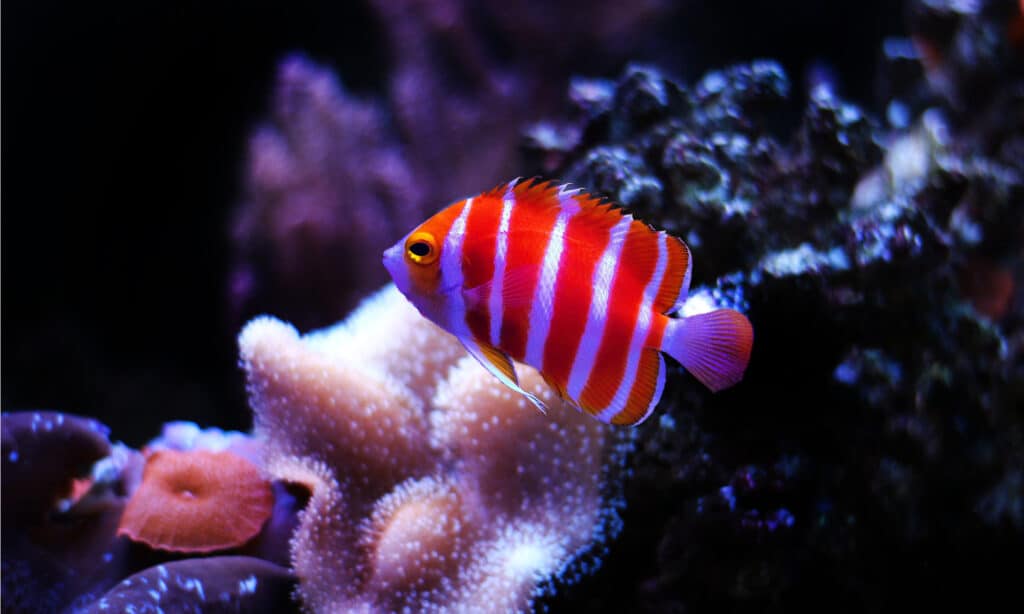Peppermint Angelfish
Centropyge boylei
The peppermint angelfish was only first described in 1992.
Advertisement
Peppermint Angelfish Scientific Classification
- Kingdom
- Animalia
- Phylum
- Chordata
- Class
- Actinopterygii
- Order
- Perciformes
- Family
- Pomacanthidae
- Genus
- Centropyge
- Scientific Name
- Centropyge boylei
Read our Complete Guide to Classification of Animals.
Peppermint Angelfish Conservation Status
Peppermint Angelfish Facts
- Prey
- Sponges, worms, crustaceans, and organic matter
- Group Behavior
- School
- Fun Fact
- The peppermint angelfish was only first described in 1992.
- Estimated Population Size
- Unknown
- Biggest Threat
- Climate change
- Most Distinctive Feature
- The alternating bands of orange and white stripes
- Other Name(s)
- Peppermint pygmy angelfish
- Gestation Period
- A few days
- Habitat
- Pacific Ocean
- Predators
- Larger fish
- Diet
- Omnivore
- Type
- Ray-finned fish
- Common Name
- Peppermint angelfish
- Number Of Species
- 1
View all of the Peppermint Angelfish images!
The peppermint angelfish has unique colors that resemble the candy for which it’s named.
These tropical fish exist at depths of the ocean which are difficult for divers to access due to the extreme pressures. They like to hide from predators around the caves and coral reefs near the bottom of the ocean. If you’re interested in acquiring one for your aquarium, then the price could be an issue. They can easily cost thousands of dollars minimum.
See all of our expert product reviews.
3 Peppermint Angelfish Facts
- Peppermint angelfish are primarily found in pairs or small groups which provide protection against predators. These fish never stray far from their hiding spots when feeding.
- As of 2019, only a single peppermint angelfish was on display anywhere in the world: this was at the Waikiki Aquarium in Honolulu.
- Peppermint angelfish generally communicate with each other through chemical signals in urine and bile.
Peppermint Angelfish Classification and Scientific Name
The scientific name of the peppermint angelfish is Centropyge boylei. Centropyge is derived from a combination of two different Greek words: kentron, meaning sting, and pyge, meaning rear end or tail. This may refer to their habit of nipping at each other’s tails. Boylei is named in honor of fish collector Charles J. Boyle who first discovered the fish. This species is most closely related to other types of pygmy angelfish, including the flame-back pygmy angelfish and the yellow pygmy angelfish.
Peppermint Angelfish Appearance
The peppermint angelfish is a small species, growing anywhere between 1 and 3 inches long. The front of the body is curved into a snout, whereas the back fins are square-shaped. The dorsal fin on the back has a spiny appearance. By far the most prominent characteristic is the five alternating vertical bright orange and white stripes along the entire body that resemble the peppermint candy for which they’re named. Their side fins and tail fin are completely translucent as well.

©vojce/ via Getty Images
Peppermint Angelfish Distribution, Population, and Habitat
The peppermint angelfish is primarily found in various locations throughout the Southern Pacific Ocean region, particularly around the Cook Islands. They prefer to hide in the rocky caves and coral reefs down to a depth of some 300 or 400 feet. According to the IUCN Red List, the peppermint angelfish is considered to be a species of least concern. Population numbers are unknown, but they appear to be widespread and stable throughout their natural range. This species has few known threats in the wild, but climate change could pose a threat to their coral reef habitats in the future.
Peppermint Angelfish Predators and Prey
The peppermint angelfish is largely omnivorous. They sift along the bottom of the ocean for small bits of food to consume.
Health and Entertainment for your Peppermint Angelfish
See all of our expert product reviews.
What eats the peppermint angelfish?
The peppermint angelfish is mostly preyed upon by sharks and other large fish. The exact predatory species are largely unknown.
What does the peppermint angelfish eat?
The peppermint angelfish consume sponges, worms, crustaceans, and other small bits of organic matter. Juveniles are more likely to consume small bits of plant and animal matter.
Peppermint Angelfish Reproduction and Lifespan
During the breeding season, the female angelfish will lay eggs in a rocky or sandy area at the bottom of the ocean. The male will fertilize the eggs externally at the same time with his sperm. The eggs are covered in tiny oil globules that allow them to float up to the plankton-rich surface. Upon hatching, the fry quickly becomes mobile and begin to feed, and they have a minimal association with their parents. The lifespan is thought to be about 20 years in captivity and likely somewhat less in the wild due to predation and disease.
Unfortunately, there is still a lot about the peppermint angelfish’s breeding behavior that we still don’t know, mostly because of the fact that the species has yet to be studied in great detail. However, there is a lot we can infer from studying closely related species. The other angelfish within the Centropyge genus are known to maintain a large harem in which a single dominant male may monopolize breeding access to multiple females; he will engage in a lengthy courtship ritual with each female in which he stimulates her to lay eggs before reproduction occurs. Pygmy angelfish are also known to be protogynous hermaphrodites, meaning females can transform into a male soon after the dominant male has been killed or removed for whatever reason. All of this is presumably true for the peppermint angelfish as well. However, this has yet to be proven definitively.
Peppermint Angelfish in Fishing and Cooking
The peppermint angelfish is not generally caught for commercial purposes because of their remote location, their fragile bodies, and their tendency to hide at depths that prove difficult to reach. As a result, they are very rare in the pet trade. Due to their rarity, the price of just one specimen can easily reach thousands of dollars.
If you ever happen to be lucky enough to own one, the fish does require special care. They need a large tank with a temperature set above 70 degrees Fahrenheit to mimic their natural habitat, and they can be fed a diet heavy in algae and frozen foods. Due to their territorial behavior and tendency to nip and bite, they are difficult to keep with other fish. However, they may get along with other species from the Cook Islands, including the longfin anthias. On the plus side, these fish have a good lifespan and a unique and interesting appearance. Reproduction has not been known to occur in captivity.
View all 192 animals that start with PPeppermint Angelfish FAQs (Frequently Asked Questions)
Where do peppermint angelfish live?
They live around many locations throughout the central South Pacific Ocean region.
How do you get a peppermint angelfish?
Peppermint angelfish are usually bought from fish stores that specialize in exotic species.
How much does a peppermint angelfish cost?
Because of how difficult they are to catch, the cost can easily run into thousands of dollars. The highest price ever paid for a peppermint angelfish was some $30,000. The cost is a huge barrier to all but the richest enthusiast aquarium owners.
What color are peppermint angelfish?
Peppermint angelfish come in alternating bands of orange and white colors. These colors vary from reddish-orange near the back to yellowish-orange near the head.
How big are peppermint angelfish?
They do not grow very large at all. A full-grown peppermint angelfish is normally less than 3 inches in size.
Thank you for reading! Have some feedback for us? Contact the AZ Animals editorial team.
Sources
- Live Aquaria, Available here: https://www.liveaquaria.com/general/general.cfm?general_pagesid=629
- Frank Baensch, Available here: https://www.frankbaensch.com/marine-aquarium-fish-culture/my-research/pygmy-angelfishes/biology/


















